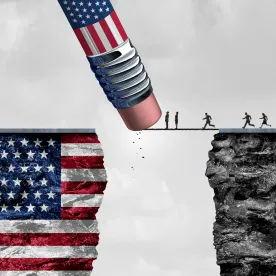Two days after teasing a temporary halt to US immigration, on April 22, 2020, President Trump issued the first of what may be multiple Presidential Proclamations aimed at stemming US immigration in response to the COVID-19 pandemic. The Proclamation, which is more limited than many expected, centers on a 60-day US entry ban for certain foreign nationals applying to permanently enter the US on “immigrant visas” (AKA green cards), but does not directly affect “nonimmigrant visas” used to temporarily visit, study, or work in the US, such as the popular H-1B, TN, F-1, or B-1/B-2 visas.
The following are answers to questions US employers may have in response to the Proclamation.
Why Now?
President Trump deemed the temporary immigration suspension necessary due to the nation’s current “high domestic unemployment and depressed demand for labor” and the need to allow consular officers to focus on providing “services to United States Citizens abroad.” He further explained that “[e]xisting immigrant visa protections are inadequate for recovery from the COVID-19 outbreak” and that “introducing additional permanent residents when our healthcare resources are limited puts strain on the finite limits of our healthcare system at a time when we need to prioritize Americans and the existing immigrant population.”
Who Will Be Affected?
The Proclamation, which becomes effective at 11:59 P.M. eastern daylight time on April 23, 2020, only applies to immigrants seeking permanent entry into the United States, not “nonimmigrants” entering to temporarily work, study, or visit. Further, immigrants must meet all three of the following requirements to be subject to the Proclamation:
-
Are outside the United States on the Proclamation’s effective date
-
Do not have an immigrant visa that is valid on the Proclamation’s effective date, and
-
Do not have an official travel document other than a visa that permits travel to the United States and seeking entry or admission.
Interestingly, the “travel documents” referred to above may be valid on the Proclamation’s effective date or issued thereafter and may include a transportation letter, an appropriate boarding foil, or an advance parole document. Such documents are often provided to applicants as part of immigrant visa and green card petitions.
Further, the Proclamation explicitly does not apply to the following categories of individuals:
1. US Lawful permanent residents (AKA green card holders)
2. Those seeking to enter on an immigrant visa
-
as a physician, nurse, or other healthcare professional;
-
to perform medical research or other research intended to combat the spread of COVID-19; or
-
to perform work essential to combating, recovering from, or otherwise alleviating the effects of the COVID-19 outbreak
3. Those applying for a visa to enter the United States pursuant to the EB-5 Immigrant Investor Program
4. The spouse of a US citizen
5. The child of a US citizen or a prospective adoptee in the IR-4 or IH-4 visa categories (under 21 years of age in both cases)
6. Anyone whose entry would further important United States law enforcement objectives, as determined and recommended by certain senior US government officials
7. Members of the United States Armed Forces and their spouses and children
8. Individuals seeking entry on a Special Immigrant Visa in the SI or SQ classification, along with their spouses and children
9. Anyone whose entry would be in the national interest, as determined by certain senior US government officials.
The Proclamation includes enough exceptions that it will likely only affect a small percentage of all employment-based petitions, those filed through US Embassies and Consulates abroad. The majority of US employers rely on “adjustment of status” processed from within the United States for their employees to obtain lawful permanent resident status and the Proclamation’s outward-facing restrictions do not appear to directly affect such cases.
Family-based immigrant visas will be widely affected. The Proclamation does not apply to applicants for asylum, refugee status, or certain other international human rights categories.
Although this Proclamation is limited in scope, it is made against a broad backdrop of existing COVID-19 immigration restrictions and bans that make even routine immigrant and nonimmigrant visa processing difficult and, at times, impossible. Routine consular visa operations at nearly all US embassies and consular posts around the world have been suspended since mid-March 2020 and US Citizenship and Immigration Services (USCIS) has temporarily suspended in-person services through at least May 3, 2020, including in-person interviews and biometrics processing related to US-based green card applications. Also, the US has established extensive travel bans, including bars to entry from many countries and significant restrictions at US borders with Canada and Mexico.
These existing restrictions have resulted in significant delays in visa processing and employers unable to fill many US positions.
How Long Will it Last?
The Proclamation will remain in effect for 60 days and can be extended or modified.
Is There More to Come?
The Proclamation explicitly requires the Secretary of Labor, the Secretary of Homeland Security, and the Secretary of State to review nonimmigrant programs and recommend “other measures appropriate to stimulate the United States economy and ensure the prioritization, hiring, and employment of United States workers.”
It is unclear whether a nonimmigrant proclamation is imminent, but many initially believed the present Proclamation would extend beyond green cards, so additional action is certainly possible. Restrictions on nonimmigrant visas would likely have a more wide-reaching effect on US employers and would likely include carve outs for certain industries, such as farming and healthcare.
Will It Stand Up In Court?
As with the president’s other immigration-related proclamations and executive orders, court challenges are likely. Given this Proclamation’s limited scope and the broad executive immigration powers recognized by the US Supreme Court in its review of prior immigration travel bans, it stands a solid chance of withstanding judicial scrutiny, although lower courts may succeed in temporarily halting its effects.





 />i
/>i
